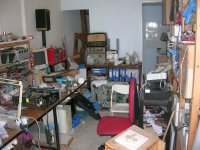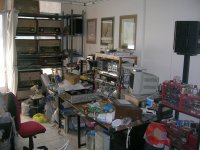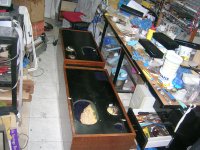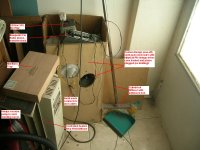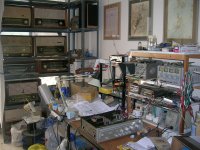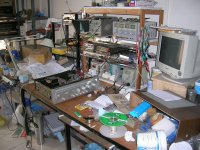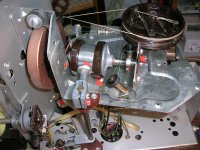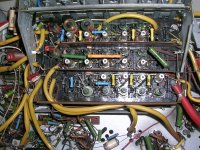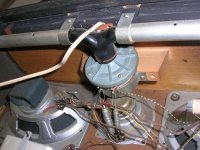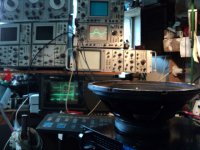Moderators
Coluke misbehaved.
He called this beauty “poor old Guzzi”
While, trondareo is a good soul
Well, it's because I just love Moto Guzzi (my two bikes * do * are Guzzi: a V11 verde legnano and a Breva 750) - that one seemed a little bit under-used (though its long winter night are not lonely).
Cheers,
L.
Well, it's because I just love Moto Guzzi (my two bikes * do * are Guzzi: a V11 verde legnano and a Breva 750) - that one seemed a little bit under-used (though its long winter night are not lonely).
Cheers,
L.
It was to be expected that you are Guzzi inflicted.😀
And that for a reason. 🙂
Regards
George
Coluke, you are forgiven!
I doubted your understanding of Guzziness, but no longer. May the long twisting road be your friend forever!
I doubted your understanding of Guzziness, but no longer. May the long twisting road be your friend forever!
Hey,gpapag take a look at these sales ads from people ending their collections : Gamle bilradioer - FINN Torget
and
Gamle radioer - FINN Torget
and
Gamle radioer - FINN Torget
Trondareo
Thank you for the links.
I always feel a pain in the stomach when I see collections ending their life.
During the last 4 years that I was searching for some radios, I have sensed this many times.
I am not a collector and even if I could afford it, I would not enjoy it.
Vintage objects, ex-belongings of other unknown to me people, makes my mind a soup of sorrow. I can not rationalise it, but it happens.
Radios are something special to me since I remember myself (many reasons, but OT).
I have bought the radios visible in the photos above (plus some more) through e-bay.de solely on the basis of one or more technical or manufacturing innovation each one had.
There are 5-6 more that I would like to have to complete this circle, but I don’t think I will make it in the foreseeable future.
But I don’t mind. With these I already have, repair and alignment, details study or just staring into their housings is more than enough for me.
Thanks again.
Regards
George
Thank you for the links.
I always feel a pain in the stomach when I see collections ending their life.
During the last 4 years that I was searching for some radios, I have sensed this many times.
I am not a collector and even if I could afford it, I would not enjoy it.
Vintage objects, ex-belongings of other unknown to me people, makes my mind a soup of sorrow. I can not rationalise it, but it happens.
Radios are something special to me since I remember myself (many reasons, but OT).
I have bought the radios visible in the photos above (plus some more) through e-bay.de solely on the basis of one or more technical or manufacturing innovation each one had.
There are 5-6 more that I would like to have to complete this circle, but I don’t think I will make it in the foreseeable future.
But I don’t mind. With these I already have, repair and alignment, details study or just staring into their housings is more than enough for me.
Thanks again.
Regards
George
Attachments
Hi SY,
You haven't seen the whole mess. Yes, much more packed in here and overflowed out into other spaces. The Mrs. is not happy at all.
Hi Choky,
How old is your dog? Looks like a happy fella for sure. I'm guessing photography is your other hobby - nice camera but I can't tell the make.
What is the make of that combination CD and receiver on your bench?
Hi Dave,
You can learn a lot from studying some old manuals. They also allow older equipment to be restored properly.
I just spent way too much money on equipment, resulting in a condition called "just plain flat broke". One reason I have so much is to retrain myself, to learn again what I knew before an accident took a lot away. So the stuff I have is way overkill for service, although I can do a much, much better job now. The types of equipment I bought has to do with research and learning. I can't afford to go back to school, so this is the next best thing.
Soon I hope to have my first real test bench in over 10 years. I'll be able to place most of my gear so it can be used, and all hand tools can go away off my bench surface. Once it has been created, I'll post more on it.
Now, I have seen many members who have some really excellent equipment to use. There are people here who have a much better selection of equipment than I do. Then there are the amazing projects people put together with expert workmanship.
The Stanford Research SR1 advertised here looks like a really good deal, and it's new! I'm going to bet it would outperform most of the older gear seen on various workbenches. Has anyone played with that, or the new Agilent U8903A yet? It looks like an amazing piece as well.
Hi Humdinger (Bob),
Nice amp case there!
You've got some really cool projects completed. You mentioned your friend's HP Spectrum Analyzer. What model is it? Really good photography showing various screens.
-Chris
You haven't seen the whole mess. Yes, much more packed in here and overflowed out into other spaces. The Mrs. is not happy at all.
Hi Choky,
How old is your dog? Looks like a happy fella for sure. I'm guessing photography is your other hobby - nice camera but I can't tell the make.
What is the make of that combination CD and receiver on your bench?
Hi Dave,
I do. It tends to last as well as hold calibration very well. I also find that operating HP / Agilent designed equipment is pretty easy as far as the user interface goes. The other thing is that the stuff also has much in the way of extra functions down in the menus. That is my current challenge, learning how to use the new (to me) stuff in more detail.It does appear you have an affection for HP/Agilent products.
It sure is!!I recall you saying that you collected vintage test equipment manuals. Is this still the case?
You can learn a lot from studying some old manuals. They also allow older equipment to be restored properly.
Don't be.I am in awe and jealousy. I don't think we have that much test equipment in the entire building where I used to work.
I just spent way too much money on equipment, resulting in a condition called "just plain flat broke". One reason I have so much is to retrain myself, to learn again what I knew before an accident took a lot away. So the stuff I have is way overkill for service, although I can do a much, much better job now. The types of equipment I bought has to do with research and learning. I can't afford to go back to school, so this is the next best thing.
Soon I hope to have my first real test bench in over 10 years. I'll be able to place most of my gear so it can be used, and all hand tools can go away off my bench surface. Once it has been created, I'll post more on it.
Now, I have seen many members who have some really excellent equipment to use. There are people here who have a much better selection of equipment than I do. Then there are the amazing projects people put together with expert workmanship.
The Stanford Research SR1 advertised here looks like a really good deal, and it's new! I'm going to bet it would outperform most of the older gear seen on various workbenches. Has anyone played with that, or the new Agilent U8903A yet? It looks like an amazing piece as well.
Hi Humdinger (Bob),
Nice amp case there!
You've got some really cool projects completed. You mentioned your friend's HP Spectrum Analyzer. What model is it? Really good photography showing various screens.
-Chris
Last edited:
Anatech, I don't know the model number of my friends HP spectrum analyzer. It's a rather large thing. High end in the old days (80's). Now days it seems that the ARTA software in a PC Laptop is the way to go. I'm in the process of getting that together (My laptop needs a bunch of drivers re-installed after I reformatted the hard drive). Linkwitz says on his website that ARTA is his main piece of test equipment these days. In my designs, I feel that distortion spectrum shape is one of the more important things to get right, so I'm really looking forward to having my own ARTA spectrum analyzer, among the many other functions it serves. My friend who already has ARTA up and running showed me that the ARTA noise floor is around -120dB, rather than the -95dB in the HP. It also generates cutting edge test signals such as the blackman burst, multibursts, and I.M. frequency combinations are apparently pretty flexible. It will be a major learning experience for me.
Hi Bob,
I'd be very careful about quoting dynamic range when you involve sound cards. Your actual ENOB (Effective number of bits) will be less than the specs would lead you to believe for one. Having as much test equipment as I do, I have an appreciation for instrument chassis and cabinet construction for shielding purposes. I haven't seen a sound card yet that can even begin to come close. Then you have the power supply and system clock to consider. Sound cards do not consider these things at all. So while a sound card is attractive, especially from a cost point of view, take the claimed performance with a grain of salt. I have two decent sound cards that I'm not using until I can create a proper "front end" for them, and also some way to isolate the computer common (or simply clean it up). The digital in and out is useful for sure, and so is the canned testing routines for quick verification. For loudspeaker testing, sound cards may be the way to go. Somehow I can't see replacing my stand alone gear just yet. In fact, I do use the HP1B bus to control and gather data to my computer. Newer gear is network compatible and I have experimented with that using equipment I can't afford. Works extremely well, but as an internal card - I'm not sure that day is here quite yet. USB connected stuff stands more of a chance, running on it's own power supply of course.
It would be neat to find out what the equipment was if it ever comes to mind. The thing about good test equipment is that the performance is somewhat better than you might think. The specs have to be certified, so they will be honest, attainable performance numbers.
As for the generated signals, I have doubts about the -120 dB noise floor as well. Sound cards simply aren't that good. Just have a look at the ad on this page for the SRS SR1 Audio Analyzer. At $8,400, it represents extremely good value. The Agilent U8903A is somewhat more expensive, and a sound card has better performance? Nope.
I think the sound card + software is an excellent way to perform tests that were unattainable for the average person a couple short years ago, but they have very real limitations that should be understood. As they are, a sound card can really only deal with line and mic level signals, plus digital formats. Signals above these levels will cause very real damage, probably permanent in nature. That and you'll need to calibrate your 0 dBu level at some point in order to take any type of accurate voltage reading. Distortion is a ratio though, so you're fine there.
Protect the input of your card at all costs!
BTW, never heard of a "Blackman burst", but I assume it compensates for the windowing used in the FFT. I'll look it up as I'm stuck in the 80s and 90s at present.
-Chris 🙂
I'd be very careful about quoting dynamic range when you involve sound cards. Your actual ENOB (Effective number of bits) will be less than the specs would lead you to believe for one. Having as much test equipment as I do, I have an appreciation for instrument chassis and cabinet construction for shielding purposes. I haven't seen a sound card yet that can even begin to come close. Then you have the power supply and system clock to consider. Sound cards do not consider these things at all. So while a sound card is attractive, especially from a cost point of view, take the claimed performance with a grain of salt. I have two decent sound cards that I'm not using until I can create a proper "front end" for them, and also some way to isolate the computer common (or simply clean it up). The digital in and out is useful for sure, and so is the canned testing routines for quick verification. For loudspeaker testing, sound cards may be the way to go. Somehow I can't see replacing my stand alone gear just yet. In fact, I do use the HP1B bus to control and gather data to my computer. Newer gear is network compatible and I have experimented with that using equipment I can't afford. Works extremely well, but as an internal card - I'm not sure that day is here quite yet. USB connected stuff stands more of a chance, running on it's own power supply of course.
It would be neat to find out what the equipment was if it ever comes to mind. The thing about good test equipment is that the performance is somewhat better than you might think. The specs have to be certified, so they will be honest, attainable performance numbers.
As for the generated signals, I have doubts about the -120 dB noise floor as well. Sound cards simply aren't that good. Just have a look at the ad on this page for the SRS SR1 Audio Analyzer. At $8,400, it represents extremely good value. The Agilent U8903A is somewhat more expensive, and a sound card has better performance? Nope.
I think the sound card + software is an excellent way to perform tests that were unattainable for the average person a couple short years ago, but they have very real limitations that should be understood. As they are, a sound card can really only deal with line and mic level signals, plus digital formats. Signals above these levels will cause very real damage, probably permanent in nature. That and you'll need to calibrate your 0 dBu level at some point in order to take any type of accurate voltage reading. Distortion is a ratio though, so you're fine there.
Protect the input of your card at all costs!
BTW, never heard of a "Blackman burst", but I assume it compensates for the windowing used in the FFT. I'll look it up as I'm stuck in the 80s and 90s at present.
-Chris 🙂
I agree that doing tests that look at even -90dB means everything, especially grounding, must be perfect. Sometimes there's still value if you're just comparing two things, even though the absolute numbers will be thrown off by noise or whatever. The Blackman burst appears to be a favorite test signal of Mr. Linkwitz for testing speaker drivers and possibly psycho-acoustic effects of listening room ringing. It's only a few cycles long, but has a minimally damaging envelop contribution, close to a gaussian shape. The thing about testing for room ringing though, is that it has a build up time that needs to be taken into consideration as well. What's worse is that if you correct for room ringing by reducing amplitude electronically of the ring frequencies, you may be throwing off the frequency response for transients, or short lived spectral content... Speaker design must be one of the most challenging things a person can try. To do it well, you almost have to get fully involved with how a given design is going to interact with the room. If you like a good challenge... 😱Hi Bob,
As for the generated signals, I have doubts about the -120 dB noise floor as well. Sound cards simply aren't that good. Just have a look at the ad on this page for the SRS SR1 Audio Analyzer. At $8,400, it represents extremely good value. The Agilent U8903A is somewhat more expensive, and a sound card has better performance? Nope.
Protect the input of your card at all costs!
BTW, never heard of a "Blackman burst", but I assume it compensates for the windowing used in the FFT. I'll look it up as I'm stuck in the 80s and 90s at present.
-Chris 🙂
Hi Bob,
At the risk of sounding like someone else around here ... I designed loudspeakers systems for pay 30 years ago now. Sheesh, what a thing to say! My tools consisted of T & S parameters and my own driver measurements, some mic cartridges that I matched and hung directly over the drivers in a multi-way speaker along with some programs I wrote on a TI-58C (the newer one!), and IBM Basic. Now that I'm truly dated ... I also still have a couple jigs I used way back then. Later on I had an Audio Control RTA thing with calibrated mics. It was pretty useful. The rest was done by ear in various locations. I almost forgot to mention the HP 4261A LCR meter I had back then. It was great to be able to measure inductance and capacitance directly. All in all, everything came together to make what was measured much closer to the calculations.
These days everything is much easier. To think what could have been done back then. Although, today I still see boxes too small because the volume of various things were not taken into account. It's surprising how much volume goes away to bracing.
At the risk of sounding like someone else around here ... I designed loudspeakers systems for pay 30 years ago now. Sheesh, what a thing to say! My tools consisted of T & S parameters and my own driver measurements, some mic cartridges that I matched and hung directly over the drivers in a multi-way speaker along with some programs I wrote on a TI-58C (the newer one!), and IBM Basic. Now that I'm truly dated ... I also still have a couple jigs I used way back then. Later on I had an Audio Control RTA thing with calibrated mics. It was pretty useful. The rest was done by ear in various locations. I almost forgot to mention the HP 4261A LCR meter I had back then. It was great to be able to measure inductance and capacitance directly. All in all, everything came together to make what was measured much closer to the calculations.
These days everything is much easier. To think what could have been done back then. Although, today I still see boxes too small because the volume of various things were not taken into account. It's surprising how much volume goes away to bracing.
Last edited:
Has anyone played with that, or the new Agilent U8903A yet? It looks like an amazing piece as well.
We just got two of the new U8903A's in the lab at work. I haven't had time to play with them yet, and I think they are destined to be used for an ATE system for torturing a new custom RF IC we are designing. They are being used as SINAD meters!
I will have been away from work for 3 weeks when I get back in about a week. Things change daily there. I will try to play with the U8903A some night after everyone else goes home since I have 3 weeks of work to catch up on.
I use an old HP8903A at home. As with most of my test equipment I bought a dead one at a hamfest and fixed it. The cal stickers tell me that it came from the Motorola paging plant in Boynton Beach Florida. I worked there for about 3 years 20 years ago. The plant was closed and buldozed about 10 years ago. A mall and upscale condo development is there now.
My lab consists of a 10 by 11 foot room with two benches, 4 computers 6 or so power supplies and stacks and racks of test equipment, mostly HP that was surplused by all of the electronics plants that have closed up and gone away, or severely downsized (including the one where I work). I'm not there so I don't have pictures, but I will stop at the Dayton hamfest on my way home for more tubes, parts and test equipment.
I have lived in the same house for 33 years and I staked out the smallest bedroom for my lab when I moved in. I built the two workbenches in place and they aren't moveable. I have convinced myself to gut the room and do it all over, but I haven't had the time, nor could I live without my place to tinker for long enough to rebuild so the mess continues to grow.
The only thing that will clean my bench is a new project... I'm not sure if it's magnetism or some kind of electrostatic charge that causes so much stuff to accumulate on my bench, but as soon as a new project gets going...
Currently looking into Power Factors for some 'speakers; so the bench looks like this pic below... getting to think that these older Tek 'scopes are beginning to breed
Down below the 'scopes is a Solartron SI 1220 being used to measure current and Voltage Phase differences for the waveforms on the Tek 465.
Not in the pic is a stack of 6 DMM's and a Timer/Frequency Meter - all 19" rackmount. and a collection of 'other instruments' such as Signal Generators, RF Voltmeters, LCR Bridge, Distortion Meter and Bench PSU's
15" Eminence sitting on top of the PSL KA501 Amplifier used to drive it; more 15" and 18" 'speakers due for testing next; purpose being to see if modern 'speakers used in PA Systems have a greater V-I Phase angle than the commonly accepted 45º maximum.
Highest figure so far at low power input is 44º for a 15" so expecting 18" and larger ones to exceed this
Mik
Down below the 'scopes is a Solartron SI 1220 being used to measure current and Voltage Phase differences for the waveforms on the Tek 465.
Not in the pic is a stack of 6 DMM's and a Timer/Frequency Meter - all 19" rackmount. and a collection of 'other instruments' such as Signal Generators, RF Voltmeters, LCR Bridge, Distortion Meter and Bench PSU's
15" Eminence sitting on top of the PSL KA501 Amplifier used to drive it; more 15" and 18" 'speakers due for testing next; purpose being to see if modern 'speakers used in PA Systems have a greater V-I Phase angle than the commonly accepted 45º maximum.
Highest figure so far at low power input is 44º for a 15" so expecting 18" and larger ones to exceed this
Mik
Attachments
Hi Bob,
In fact, I do use the HP1B bus to control and gather data to my computer. -Chris 🙂
Chris, or others for that mater...
I'm now the proud owner of an HP8903a and a Hp spectrum analysizer. I'm interested in capturing data from these machines to make what I would call digital plots. Could you point me to literature that explains how to do this? What software I would need, that sort of thing. Any help would be appreciated.
Thanks
Ken
P.S. I would just like to second the bit about the sound cards, they are very helpful, but readings like THD are suspect when compared to what the HP machines tell us. Even the sin signal out is pretty nasty compared to the HP signal out.
- Home
- Design & Build
- Equipment & Tools
- What's on your workbench???
